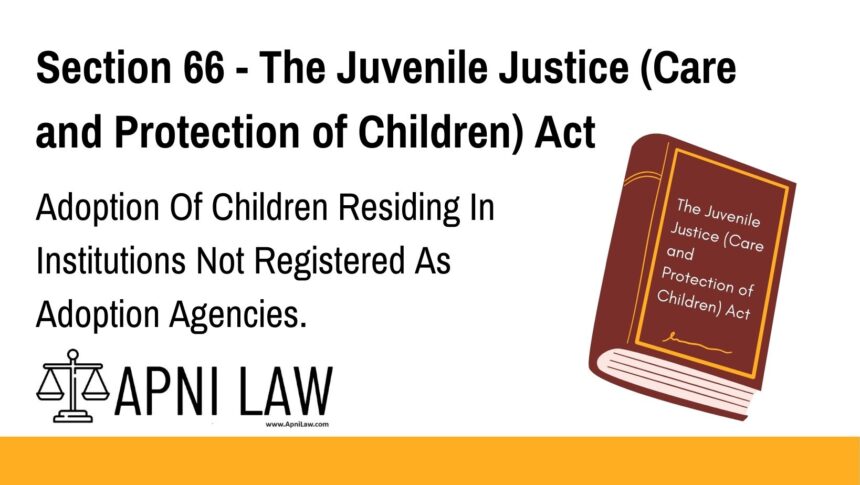Code: Section 66 JJ Act
(1) All the institutions registered under this Act, which may not have been recognised as Specialised Adoption Agencies, shall also ensure that all orphan or abandoned or surrendered children under their care are reported, produced and declared legally free for adoption, by the Committee as per the provisions of section 38.
(2) All institutions referred to in sub-section (1) shall develop formal linkages with nearby Specialised Adoption Agency and shall furnish details of the children declared legally free for adoption to that Specialised Adoption Agency along with all relevant records in the manner as may be prescribed, for the placement of such children in adoption.
(3) If any such institution contravenes the provisions of sub-section (1) or sub-section (2), it shall be liable to fine of fifty thousand rupees for each instance to be imposed by the registering authority and it may also attract de-recognition in the event of persistent flouting of such provisions.
Explanation of Section 66 JJ Act
Section 66 addresses the responsibility of child care institutions (CCIs) that are registered under the Juvenile Justice Act but are not recognised as Specialised Adoption Agencies (SAAs). These institutions still have legal duties when it comes to handling cases of orphaned, abandoned, or surrendered children in their care.
Key Takeaways:
- Institutions that are not SAAs must still report and produce children before the Child Welfare Committee (CWC) to declare them legally free for adoption as per Section 38.
- Such institutions must build a formal working relationship with a nearby SAA.
- After a child is declared legally free, the institution must share all records with the SAA to proceed with the adoption.
- Failure to comply results in a fine of ₹50,000 for each instance. Repeated violations may lead to the institution being de-recognised by the registering authority.
This section ensures that no eligible child is left out of the adoption system just because of the administrative status of the institution in which they reside.
Illustration
Example 1: Linkage with SAAs
A registered shelter home houses three orphaned children. It is not recognised as an SAA. Under Section 66, the shelter must present the children before the CWC for adoption clearance and then coordinate with a nearby SAA to manage the adoption process.
Example 2: Penalty for Non-Compliance
A non-SAA institution refuses to report children eligible for adoption. Upon inspection, authorities find that no steps were taken to declare the children legally free or link with an SAA. The registering authority imposes a fine of ₹50,000 per child and warns of de-recognition if violations continue.
Common Questions and Answers on Section 66 JJ Act
- Do non-SAA institutions have adoption-related responsibilities?
Yes. Even if an institution is not an SAA, it must report eligible children for adoption and coordinate with a recognised SAA. - What is the process for adoption through a non-SAA institution?
The child must be declared legally free by the CWC. Then, the institution must hand over the case to a nearby SAA for adoption placement. - What happens if the institution does not comply?
It will face a fine of ₹50,000 for each case. Repeated non-compliance can lead to the cancellation of its registration. - Why is coordination with SAAs important?
SAAs have the expertise and recognition required to place children in legal, ethical, and successful adoptions. - How does this help orphaned children?
It ensures every eligible child, regardless of the institution’s status, has a fair chance of being adopted and raised in a family environment.
Conclusion
Section 66 closes a critical gap in the adoption framework by holding all registered child care institutions accountable—even if they are not recognised SAAs. It mandates that no eligible child is left behind due to administrative or logistical hurdles. This provision strengthens India’s child welfare ecosystem by improving inter-agency collaboration and ensuring timely adoption placements.
For more legal resources and child protection updates, visit ApniLaw.








